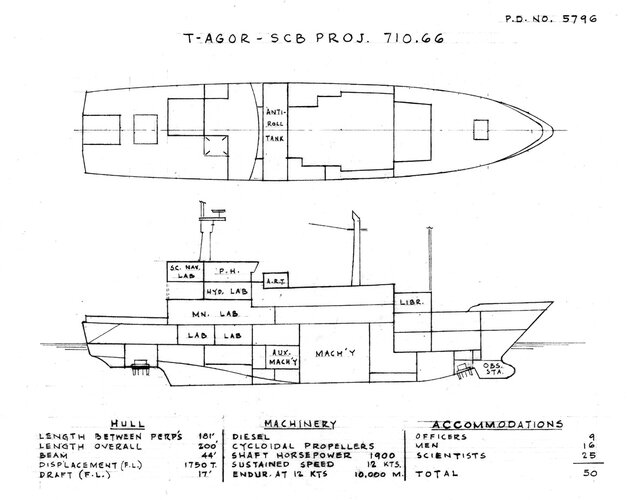A Tentative Fleet Plan
I really should change my personal text
- Joined
- 9 April 2018
- Messages
- 1,154
- Reaction score
- 2,557
Mars class (AFS-1) Solid Stores Ship SCB 208, 705.65 & 705.66
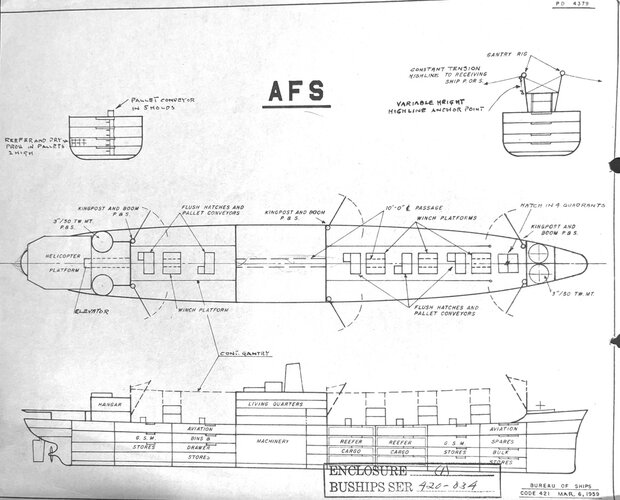
AFS Preliminary Design 4379, March 1959
A slightly oblique view of a preliminary design general arrangement sketch dated 6 March 1959 of a proposed store ship (AFS) that was attached to a BUSHIPS feasibility and cost study of the ship dated 24 March 1959. Of particular interest is the gantry structure (shown in solid lines on the plan view and dashed lines on the side view as well as in the inset at upper right) which provided "simplicity and flexibility in highline location." A continuous centerline route for pallet trucks ran from number 1 hold to the helicopter platform elevator, but according to this drawing it was not covered as it was in later designs.
Photo No. None
Source: NARA: RG 19 Entry P 62 Box 98
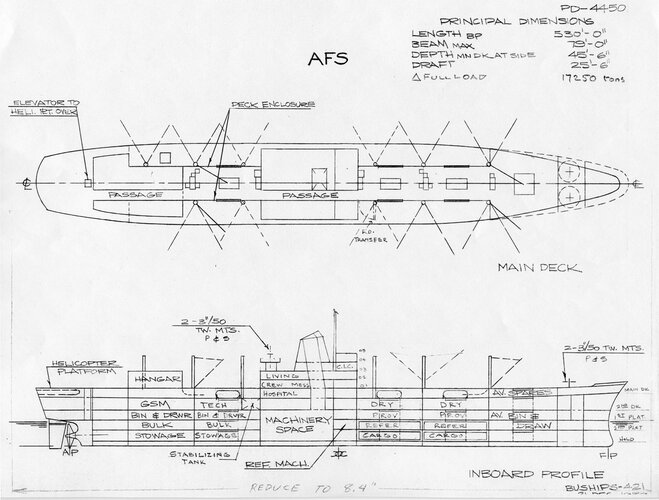
AFS Preliminary Design 4450, December 1959
A preliminary design sketch of the new AFS dated 31 December 1959, shortly before the Ship Characteristics Board issued its approved characteristics for the ship. It appears to show the ship largely as built, although it does not show the changes, notably in cargo stowage, made during the contract design phase. Note the garage door type openings in the sides of the centerline cargo handling deckhouse.
Photo No. None
Source: U.S. Naval History and Heritage Command
Source
Further information on both preliminaries
SCB 217 Oiler for FY63
A new design of fleet oiler (AO) was included in the tentative FY 1962 building program. The major change in the FY 1962 AO from SCB Projects No. 82 and 82A, as directed by OpNav on 13 April 1960, was the requirement for a sustained speed of 20 knots vice a trial speed of 20 knots and for three boilers instead of two. The magnitude of the changes caused the assignment of a new project number, SCB 217, and aroused concerns over cost. Final characteristics adopted at a working level meetins of the SCB on 20 September 1960 included a full load displacement of 38,296 tons, dimensions of 655' oa x 94' x 35' full load, a crew of 325 men, a cargo capacity of about 150,000 barrels, twin screws, an armament of four 3"/50 twin mounts, and a helicopter platform (added in September 1960). There were four fueling stations to port and two to starboard plus one stores transfer rig on each side. By September 1960 SCB 217 was no longer in the FY 1962 program, and design work on it soon ceased. A March 1961 draft of the FY 1963 program again included a new oiler (AO). Approved characteristics for an oiler (AO), SCB Project No. 217, were promulgated on 20 September 1961 without later changes. The ship was soon competing in budget planning with the AOR, causing the SCB to protest in October 1961 that the AO carried more NSFO (the fuel most needed by the fleet) than the AOR and was somewhat less expensive. The AOR along with jumboized World War II T3 oilers (AO 105 and 51 classes) ultimately prevailed in the FY 1963-1967 programs.
Source
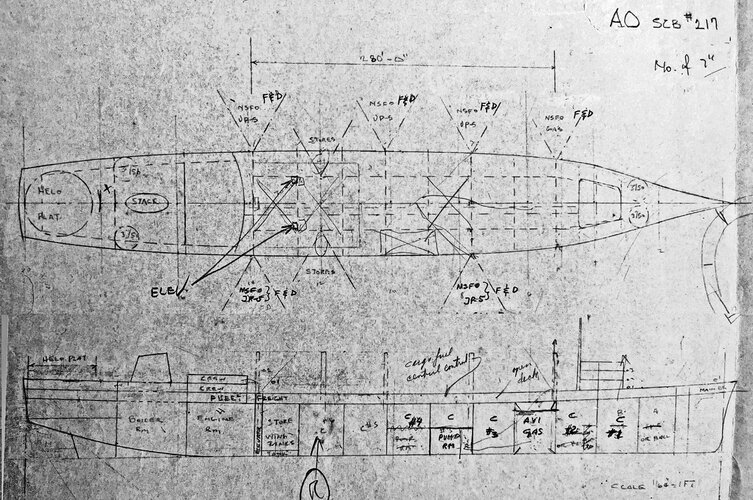
SCB Project No. 217
This design, developed in 1960-61 for the FY 1962 and then the FY 1963 building programs, was similar to the AO 143 class but had a higher speed and a third boiler. This rough sketch appears to show the design just after the Ship Characteristics Board added a helicopter platform in September 1960. The SCB 217 AO was replaced in the building program by the AOR 1 class.
Photo No. None
Source: U.S. National Archives (RG-19) Entry P 26 box 21
Source
Kilauea class (AE-26) Ammunition Ship SCB 703.65 & 703.66
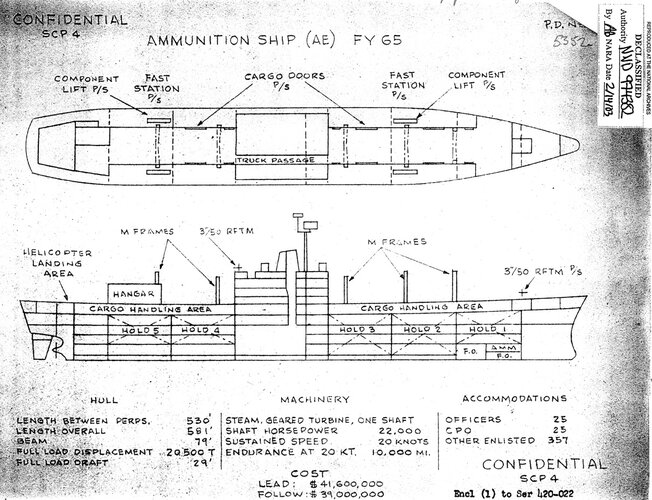
Preliminary Design for FY 1965 AE
This, the first preliminary design for an AE in the Fiscal Year 1965 building program, was based on the Maritime Administration's Mariner C4 cargo ship and generally resembled the FY 1961 Mars (AFS 1) class. Between the production of this design in April 1963 and the approval of the final characteristics for the AE 26 class in March 1964 the layout of the design was radically altered.
Photo No. None
Source: NARA RG 19 Entry P 62 Box 75 (SCB 249) and RG 19 Entry P 26 Boxes 7-9
Source
Further Information
USNS Comet (T-AK-269/T-LSV-7/T-AKR-7) MA C3-ST-14a
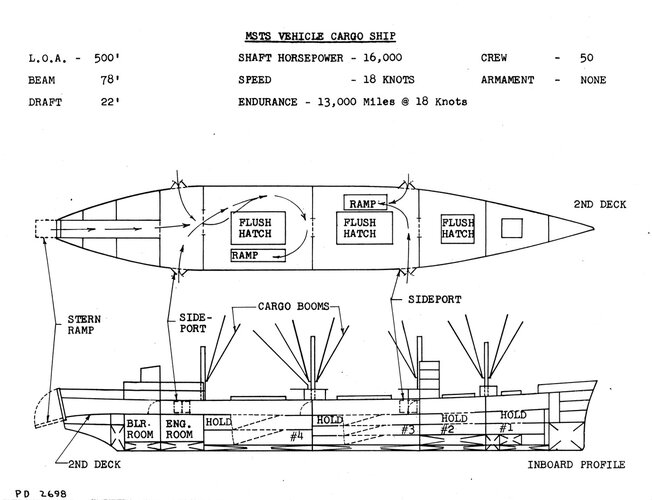
Navy design for T-AK 269
The Bureau of Ships design for the ship (PD 2698) after changes requested by MSTS were incorporated in it in early June 1954 and before it was set aside in late June 1954 in favor of a very different design by the design agent for the ship, George G. Sharp.
Photo No. None
Source: U.S. Naval History and Heritage Command
Source
Further Information
USNS Sea Lift/Meteor (T-LSV-9/AKR-9) SCB 236 and 712.65 and MA C4-ST-67a
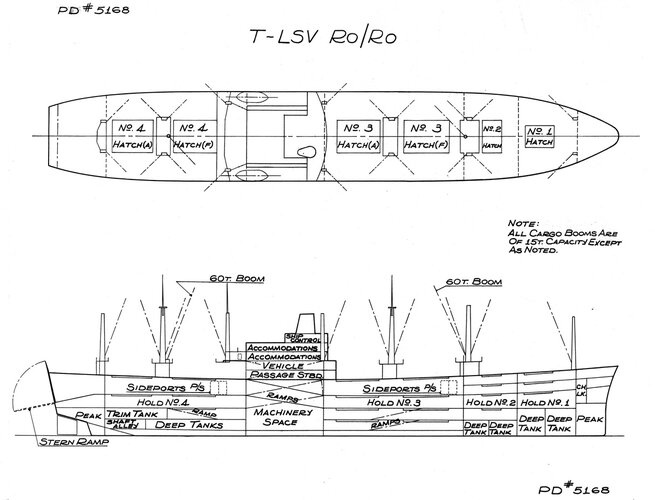
USNS Sea Lift (T-LSV 9)
A preliminary design drawing showing the design after a reconfiguration of the superstructure and nearly in its final form before transfer to the design agent, George G. Sharp. Note the two long vehicle holds with the ramps, machinery space, and vehicle passage through the deckhouse between them. This drawing was reproduced in the publicity brochure for the ship released by the Bureau of Ships on 21 November 1962.
Photo No. None
Source: NHHC, NARA RG 1
Source
Further Information
Last edited:

